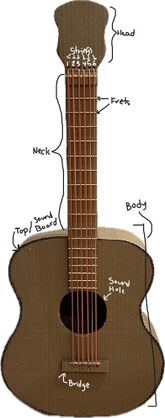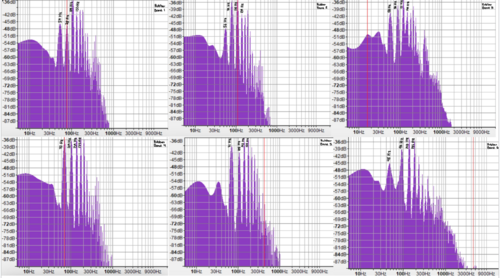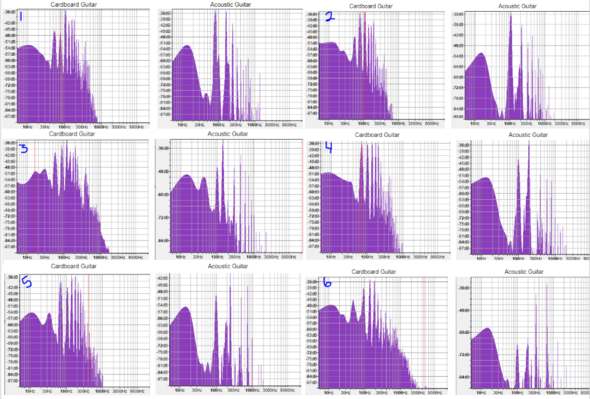PHYS341/2024/Project2
Cardboard Guitar
Without spending hundreds on an acoustic guitar, one can study the concepts of physics such as resonance and sound waves by building a guitar out of cardboard along with some toothpicks, rubber bands, paperclips, and hot glue.
Background Material:
Sound waves:
The results of vibrations from an object such as a string or a rubber band cause sound waves. When the object vibrates, it displaces air molecules that are nearby. The frequency that these air molecules vibrate at would be equal to the vibration frequency of the vibrating object. These displacements of air molecules are caused by the vibrations that would cause air to displace neighbouring air molecules. For example, when air molecules displace to the right, there would be lower pressure and density on the left compared to the right where there would be higher pressure and density. The differences in pressure results in regions where there are compressions and rarefactions. These regions are what we call sound waves. Lastly, The displaced air molecules lead the surrounding air molecules to be displaced which propagates the wave further. The continuous displacement between air molecules creates travelling sound waves.
Acoustic guitar materials:
Nowadays, modern acoustic guitars are made out of wood. Typical woods used for the body and neck of a guitar are Mahogany, Ash, Maple, Basswood, Agathis, Alder, Poplar, Walnut, Spruce, and holly. Frets and strings are made out of metal. Different types of wood used would have their own uniqueness in acoustic properties and produce different sounds and resonances at different frequencies[1]. The top of the guitar, also known as the soundboard, plays a crucial role in producing sound because the wood is lighter. The lightness offers better sound transmission compared to the sides and back of the guitar[2].
Construction and Measurements:
Construction:
The guitar body and neck was constructed with different layers of cardboard that was cut and shaped to resemble an acoustic guitar. The top and back part of the body was made from two layers of cardboard (1 piece of cardboard glued to another piece) while the sides were made with a single layer. Toothpicks were glued to the neck (4 layers of cardboard) of the guitar to resemble the frets. (Refer to Fig. 1). For the 6 rubber bands representing the strings, they were individually stretched from the neck to the bridge of the guitar, each with different tension applied and tied off with paper clips to secure them on each end (Fig 1.1).
Measurements:
Cardboard guitar:
- 85.4 cm overall length (head + neck + body)
- 40.6 cm body length
- 11.1 cm body depth
- 30.9 upper body width
- 26 cm mid-body width
- 35.5 cm lower body width
- 10.2 cm sound hole diameter
Rubber bands:
- 0.3 cm rubber band width (unstretched)
- 0.1 cm rubber band depth (unstretched)
- 35 cm rubber band length (unstretched)
How it works:
The cardboard guitar contains rubber bands that run from the neck of the guitar to the bridge/body of the guitar, in a similar fashion to an acoustic guitar. These rubber bands resemble guitar strings. The rubber bands would vibrate at a frequency determined by its tension, length and mass when a force is applied to it (plucked). The vibrations would travel along the length of the rubber band to the bridge of the guitar. The bridge is the connection point between the strings and the body of the guitar therefore, the vibrations would get transferred from the rubber band to the top/soundboard, side, and back of the body[2], causing air molecules inside to resonate. Not only would it cause resonance, but it would also cause oscillations. These oscillations cause the cardboard to flex and vibrate at the same frequency as the rubber band, which would amplify the sound that is being produced. The oscillations would also transmit energy to the surrounding air, causing a disturbance in neighbouring air molecules. These disturbances result in sound waves which emit sound from the sound hole of the guitar[2].
Measurement of Sound Properties:
Measuring the resonant frequencies (Fig 2) and individual frequencies (Fig 2.1) of the rubber bands can give us insights into the cardboard guitars characteristics and acoustics. The measurements of the different frequencies produced by each individual rubber band tightened at different tensions would be through the use of Audacity and its spectrum plot. The fundamental frequency and harmonics are identified through the different peaks in the spectrum plot where the first peak is the fundamental frequency and following peaks are harmonics. To get how many times the fundamental each harmonic has, simply divide the harmonic frequency by the fundamental. Additionally, the resonant frequency would be measured through resulting peaks in the spectrum plot by tapping the top of the guitar body (Aud. 1). Note that the characteristics for the 6 rubber bands are all the same except for the tension as seen in Fig. 1.1.
Individual Frequencies and Harmonics of Rubber Bands:
Refer to Fig 1 on string/rubber band ordering and Fig 1.1 on string/rubber band tension
Rubber band 1 (least tension):
- Fundamental frequency: 54 Hz
- First harmonic: 78 Hz - 1.44x Fundamental
- Second harmonic: 109 Hz - 2.02x Fundamental
- Third harmonic: 133 Hz - 2.46x Fundamental
Rubber band 2:
- Fundamental frequency: 56 Hz
- First harmonic: 79 Hz - 1.41x Fundamental
- Second harmonic: 110 Hz - 1.96x Fundamental
- Third harmonic: 139 Hz - 2.58x Fundamental
Rubber band 3:
- Fundamental frequency: 58 Hz
- First harmonic: 89 Hz - 1.53x Fundamental
- Second harmonic: 121 Hz - 2.09x Fundamental
- Third harmonic: 149 Hz - 2.57x Fundamental
Rubber band 4:
- Fundamental frequency: 72 Hz
- First harmonic: 104 Hz - 1.44x Fundamental
- Second harmonic: 139 Hz - 1.93x Fundamental
- Third harmonic: 175 Hz - 2.43x Fundamental
Rubber band 5:
- Fundamental frequency: 71 Hz
- First harmonic: 108 Hz - 1.52x Fundamental
- Second harmonic: 142 Hz - 2.00x Fundamental
- Third harmonic: 179 Hz - 2.52x Fundamental
Rubber band 6 (most tension):
- Fundamental frequency: 48 Hz
- First harmonic: 94 Hz - 1.96x Fundamental
- Second harmonic: 140 Hz - 2.92x Fundamental
- Third harmonic: 186 Hz - 3.88x Fundamental
Comparison to Acoustic Guitar:
When being compared with an acoustic guitar, the harmonics of the cardboard guitar aren’t perfect multiples of the fundamental like harmonics on an acoustic guitar. The harmonics on an acoustic guitar are all multiples of the fundamental (2f, 3f, 4f, etc.) while the harmonics on the cardboard guitar aren’t (Fig. 3). The reason why this is the case is that even though the rubber bands are standing waves with fixed ends, it is due to differences in the physical properties of rubber bands compared to traditional guitar strings.
Note that the acoustic guitar used (Fig. 3.1) is out of tune, affecting the fundamental multiples of the harmonics.
String 1:
- Fundamental frequency: 82 Hz
- First harmonic: 163 Hz - 1.99x Fundamental
- Second harmonic: 245 Hz - 2.99x Fundamental
- Third harmonic: 327 Hz - 3.99x Fundamental
String 2:
- Fundamental frequency: 109 Hz
- First harmonic: 217 Hz - 1.99x Fundamental
- Second harmonic: 325 Hz - 2.98x Fundamental
- Third harmonic: 433 Hz - 3.97x Fundamental
String 3:
- Fundamental frequency: 100 Hz
- First harmonic: 143 Hz - 1.43x Fundamental
- Second harmonic: 287 Hz - 2.87x Fundamental
- Third harmonic: 431 Hz - 4.31x Fundamental
String 4:
- Fundamental frequency: 101 Hz
- First harmonic: 192 Hz - 1.90x Fundamental
- Second harmonic: 387 Hz - 3.83x Fundamental
- Third harmonic: 580 Hz - 5.74x Fundamental
String 5:
- Fundamental frequency: 100 Hz
- First harmonic: 200 Hz - 2.00x Fundamental
- Second harmonic: 244 Hz - 2.44x Fundamental
- Third harmonic: 487 Hz - 4.87x Fundamental
String 6:
- Fundamental frequency: 100 Hz
- First harmonic: 199 Hz - 1.99x Fundamental
- Second harmonic: 329 Hz - 3.29x Fundamental
- Third harmonic: 658 Hz - 6.58x Fundamental
Aspects of Construction that Affect Sound:
Several aspects of the construction significantly affect the sound produced by the cardboard guitar such as size, shape, material and tension.
Size and shape:
The size and shape of the guitar body plays a significant role in how an overall sound is produced as it influences characteristics such as tone and resonance. If the body of the cardboard guitar was larger, it would produce a deeper, fuller and more resonant sound than if it was smaller since it would produce more muted, and less resonant tone. Being smaller in size also limits its low-end response and overall volume. For deeper, more rounded bodies, the guitar would produce a warmer, bassier sound when compared to shallower, flatter bodies. Shallow and flat bodies tend to produce brighter and trembly toned sounds[3].
String material and tension:
Different materials used in rubber bands have an effect on the sound it produces. Materials such as synthetic rubber and natural rubber result in different elasticity and density due to them being made out of different types of material. The materials used in synthetic rubber have lower density (1.22 g/cm^3) and elasticity while materials in natural rubber have higher density (1.34 g/cm^3) and elasticity[4]. Although natural rubber has a higher density, usually meaning lower speeds of sound, its high elasticity tends to have a greater influence on the speed of sound rather than density therefore, it would result in higher speeds of sound[5]. Higher speeds of sounds allow waves to travel more quickly than lower speeds, affecting the time it takes to reach a listener's location. Although these speeds don't affect the sound being produced, they influence characteristics on sound wave propagation, impacting sound being perceived[6].
Tension impacts production of sound. When higher tensions are applied, it results in higher frequencies and pitch. But, when less tension is applied, it results in lower frequencies and pitch. When adjusting tension, we are simply altering pitches to make them a certain tune[5].
References:
- ↑ "Guitar Manufacturing". Wikipedia. Retrieved 2024-04-12.
- ↑ 2.0 2.1 2.2 "The Structure of the Acoustic Guitar: How a guitar makes sound - Musical Instrument Guide - Yamaha Corporation". Yamaha. Retrieved 2024-03-29.
- ↑ "Acoustic Guitar Body Sizes Explained". Sound Pure. Retrieved 2024-03-29.
- ↑ "Materials". Suebel. Retrieved 2024-04-13.
- ↑ 5.0 5.1 "Nondestructive Evaluation Physics: Sound". Iowa State University: Center for Nondestructive Evaluation. Retrieved 2024-03-30.
- ↑ "Speed of Sound". Khan Academy. Retrieved 2024-04-13.





